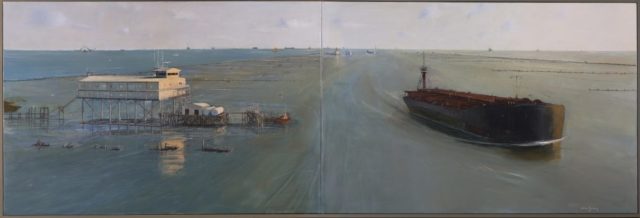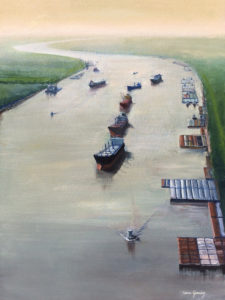Fall 2016
The Power of the River
Australian artist Simon Gunning called New Orleans home and became fascinated with the power of the Mississippi
Published: September 6, 2016
Last Updated: September 17, 2018
Born and raised in Sydney, Australia, serendipity brought Gunning to New Orleans, but affinity kept him there. For all the differences between New Orleans and his home, Gunning always appreciated water, and saw it in depth. Having grown up on Sydney Harbor, Gunning was an avid sailor and fisherman, and began capturing marine landscape scenes during early childhood. Gunning left his native country in the 1970s after winning a graduate fellowship to study painting in London. On his way, he traveled through the United States, spending time in New York City and New Orleans. During his time in New Orleans, he was captivated by the city’s urban landscape set amongst a lush backdrop of tropical flora and cypress swamps.
Instead of accepting his fellowship in London, Gunning officially moved to the Crescent City. He worked as a waiter at Napoleon House, lived deep in the Marigny and painted. He painted street scenes, ships and the river. From his attic studio, he could see ships rising high above the levee, ships whose decks looked down on the city as they slid past. They carried with them mystery, power and a sense of the wide world. So did the Mississippi River, only more so.
It wasn’t the natural beauty of the river that drew him in. It was the river’s power. Years ago, Gunning referred to the Mississippi as “a challenge and a new mistress… At first she was stubborn and closed — not much at all, wide flat and pale. That’s what I thought. But I was wrong. I just hadn’t looked. My mind was also stubborn and closed. Eventually I learned my new mistress was hostile, industrial and dangerous.” He began painting the river, “not as some silly romantic notion, but the hard-core, industrial, physical nature of the river, the real river.”
The river itself is all movement, change and turbulence. But it also creates place, for, as much power to destroy as the Mississippi River has, even more it has the power to create. The river does not simply define New Orleans and all of south Louisiana, the river created south Louisiana.
At one time, many of Louisiana’s coastal parishes were ocean. A combination of falling sea levels and sediment carried and deposited by the Mississippi River and what are now its tributaries transformed ocean into land. When the river met the sea, when the current could no longer carry or push the sediment against this force, it began to drop out, creating sandbars, then mudflats. Grasses grew upon them, creating marsh and more obstruction. Willow and cypress trees grew, and the ground became solid.The natural process that built the Louisiana coast is dynamic in the extreme. There is nothing permanent about it. The river and its sediment built the land, but they left it not much more permanent than a sandcastle awaiting the tide, and human engineering has made the land infinitely more fragile.

The Entrance, by Simon Gunning, 2005. Courtesy of Coleman E. Adler II, photo by Will Crocker.
One of Gunning’s paintings in particular, “The Entrance,” brings the story of the river and Louisiana together. The title refers to the entrance into the river channel from the ocean, and the viewpoint is from within the channel, looking south into the ocean. Two jetties, barely visible as lines on the surface of the water, define the line of demarcation where the river ends and the ocean begins.
The jetties themselves represent humans’ first real assertion of power over the river, creating the concentrated force that opened the river for commerce. The painting captures a fundamental fact of the jetties: their success contributes to the greatest problem facing the Louisiana coast. The very power that allowed the current to cut through the sandbar also provides enough energy to continue to carry sediment into deep water, where it drops into the ocean off the Continental Shelf and is of no use to preserving land anywhere in coastal Louisiana.
Will coastal Louisiana survive, or will Gunning’s paintings become not only works of art, but also historical documentation of a place that has vanished?
Simon Gunning and the Southern Louisiana Landscape was on view at the Ogden Museum of Southern Art beginning October 1, 2016 until February 5, 2017. The opening reception took place on October 1 during Art for Art’s Sake.

